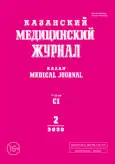Цены на лекарства в 2017 и 2018 гг. как отражение эффективности государственных мер по обеспечению доступности лекарственных средств
- Авторы: Раззакова Ч.М.1, Зиганшина Л.Е.1
-
Учреждения:
- Казанский государственный медицинский университет
- Выпуск: Том 101, № 2 (2020)
- Страницы: 256-263
- Тип: Социальная гигиена и организация здравоохранения
- URL: https://journals.rcsi.science/kazanmedj/article/view/19279
- DOI: https://doi.org/10.17816/KMJ2020-256
- ID: 19279
Цитировать
Полный текст
Аннотация
Цель. Проведение сравнительного анализа цен на лекарства в 2017 и 2018 гг. в г. Казани (Республика Татарстан, Российская Федерация) для оценки эффективности государственных мер по обеспечению доступности лекарственных средств.
Методы. Мы провели сравнительный анализ цен на лекарства с использованием методологии, разработанной международной организацией «Международная программа действий для здравоохранения» совместно с Всемирной организацией здравоохранения. Анализ включал 30 лекарств в заранее заданной форме и дозировке. Изучали наличие и цены оригинальных брендов и генериков по наименьшей цене в государственных и частных аптеках Казани в 2017 и 2018 гг., а также закупочные цены на эти же лекарства в стационарах. Цены на лекарства сравнивали с международными референтными ценами Международного указателя цен лекарств организации MSH (Management Sciences for Health) и выражали в медианах отношения цен к референтным.
Результаты. Цены на оригинальные бренды и генерические препараты в государственном и частном секторах имели тенденцию к снижению в 2018 г. по сравнению с 2017 г., но статистически значимое снижение цен произошло только на генерические препараты в частном секторе. Так, показатели медиан отношения цен к референтным оригинальных брендов изменились с 6,86 до 2,97 в государственном секторе и с 11,1 до 5,36 в частном секторе в 2018 г. относительно 2017 г., но анализ не показал статистически значимой разницы (р >0,05). Цены на генерические препараты в государственном секторе не претерпели изменений и оставались на уровне референтных цен (медиана отношения цен к референтным составляла 1,3 в 2017 г. и 1,27 в 2018 г.). Однако в частном секторе выявили двукратное снижение цен на генерические препараты в 2018 г. относительно 2017 г. [снижение медианы отношения цен к референтным от 3,25 до 1,44 (р <0,05)]. Цены на генерические препараты, закупленные для стационаров в 2017 и 2018 гг., не претерпели статистически значимых изменений с показателями медиан отношения цен к референтным — 1,34 и 0,8 соответственно.
Вывод. Государственные меры по регулированию цен способствовали сохранению цен на генерические препараты на уровне референтных в государственном секторе и двукратному снижению цен на генерические препараты в частном секторе в 2018 г. относительно 2017 г.
Ключевые слова
Полный текст
Открыть статью на сайте журналаОб авторах
Чинара Маратовна Раззакова
Казанский государственный медицинский университет
Автор, ответственный за переписку.
Email: chinara345@mail.ru
Россия, г. Казань, Россия
Лилия Евгеньевна Зиганшина
Казанский государственный медицинский университет
Email: chinara345@mail.ru
ORCID iD: 0000-0003-1999-0705
SPIN-код: 6061-7223
Scopus Author ID: 7004193381
Россия, г. Казань, Россия
Список литературы
- Government of the Netherlands. Keeping medicines affordable. https://www.government.nl/topics/medicines/keeping-medicines-affordable (access date: 28.01.2020).
- Health Action International. Pricing & related policies. https://haiweb.org/what-we-do/price-availability-affordability/resources-for-pricing-policies/ (access date: 28.01.2020).
- Health Action International. New and affordable medicines in the Netherlands: Tracing the Dutch Government’s Policy Commitments and Actions. https://haiweb.org/wp-content/uploads/2019/06/NL-Government-Commitments-on-New-Affordable-Medicines-1.pdf (access date: 28.01.2020).
- Постановление Правительства РФ от 29 октября 2010 г. №865 «О государственном регулировании цен на лекарственные препараты, включённые в перечень жизненно необходимых и важнейших лекарственных препаратов». https://www.rosminzdrav.ru/documents/7459-postanovlenie-pravitelstva-rf-865-ot-29-oktyabrya-2010-g (дата обращения: 28.01.2020).
- Раззакова Ч.М., Зиганшина Л.Е. Изменение ценовой доступности лекарственных препаратов в Казани в 2010 и 2015 годах как отражение государственных мер по регулированию цен на лекарства. Казанский мед. ж. 2017; (5): 822–826. doi: 10.17750/KMJ2017-822.
- Раззакова Ч.М., Зиганшина Л.Е. Цены на сердечно-сосудистые лекарственные препараты как показатель доступности лекарств для их рационального использования. Рационал. фармакотерап. в кардиол. 2019; 15 (2): 215–223. doi: 10.20996/1819-6446-2019-15-2-215-223.
- Постановление правительства РФ от 3 февраля 2016 г. №58 «О внесении изменений в Постановление Правительства РФ от 29 октября 2010 г. №865 “О государственном регулировании цен на лекарственные препараты, включённые в перечень жизненно необходимых и важнейших лекарственных препаратов”».
- Health Action International. Measuring medicine prices, availability, affordability and price components. 2nd ed. https://haiweb.org/price-availability-affordability/collecting-evidence-on-medicine-prices-availability/ (access date: 28.01.2020).
- Management Sciences for Health. International drug price indicator guide. http://mshpriceguide.org/en/home/ (access date: 28.01.2020).
- Cameron A.М., Ewen M., Ross-Degnan D. et al. Medicine prices, availability, and affordability in 36 developing and middle-income countries: a secondary analysis. Lancet. 2009; 373 (9659): 240–249. doi: 10.1016/S0140-6736(08)61762-6.
- Babar Z.U., Ibrahim M.I., Singh H. et al. Evaluating drug prices, availability, affordability, and price components: Implications for access to drugs in Malaysia. PLoS Med. 2007; 4 (3): e82. doi: 10.1371/journal.pmed.0040082.
- Khuluza F., Haefele-Abah C. The availability, prices and affordability of essential medicines in Malawi: A cross-sectional study. PLoS ONE. 2019; 14 (2): e0212125. doi: 10.1371/journal.pone.0212125.
- Dabare P., Wanigatunge C., Beneragama B. A national survey on availability, price and affordability of selected essential medicines for non communicable diseases in Sri Lanka. BMC Public Health. 2014; 14 (1): 817–831. doi: 10.1186/1471-2458-14-817.
- Health Action International. Medicine prices, availability, affordability & price components database. https://haiweb.org/survey-related-reports/ (access date: 28.01.2020).
- Имаева А.Э., Баланова Ю.А., Концевая А.В. и др. Наличие и доступность препаратов для лечения сердечно-сосудистых заболеваний в аптеках шести регионов Российской Федерации. Рационал. фармакотерап. в кардиол. 2018; 14 (6): 804–815. doi: 10.20996/1819-6446-2018-14-6-804-815.
- Распоряжение от 23 октября 2017 г. №2323-р «Об утверждении перечня жизненно необходимых и важнейших лекарственных препаратов для медицинского применения на 2018 год». http://government.ru/docs/29758/ (дата обращения: 28.01.2020).
- Постановление Правительства РФ от 28 ноября 2013 г. №1086 «Об утверждении Правил формирования перечня лекарственных средств, закупка которых осуществляется в соответствии с их торговыми наименованиями». http://minfin.tatarstan.ru/normativno-pravovie-dokumenti-v-sfere-zakupok.htm?page=2 (дата обращения: 28.01.2020).
- Постановление Правительства Российской Федерации от 15 ноября 2017 г. №1380 «Об особенностях описания лекарственных препаратов для медицинского применения, являющихся объектом закупки для обеспечения государственных и муниципальных нужд». http://government.ru/docs/30157/ (дата обращения: 28.01.2020).
- Приказ Министерства здравоохранения Российской Федерации от 26.10.2017 №871н «Об утверждении Порядка определения начальной (максимальной) цены контракта, цены контракта, заключаемого с единственным поставщиком (подрядчиком, исполнителем), при осуществлении закупок лекарственных препаратов для медицинского применения». http://publication.pravo.gov.ru/Document/View/0001201711280009 (дата обращения: 28.01.2020).
- Федеральная антимонопольная служба России. Доклад о состоянии конкуренции в Российской Федерации за 2017 г. https://fas.gov.ru/documents/658027 (дата обращения: 28.01.2020).
Дополнительные файлы






